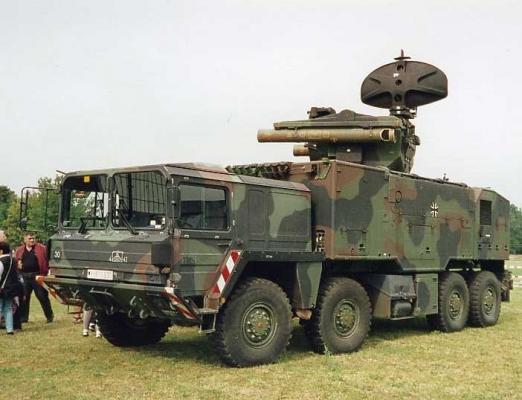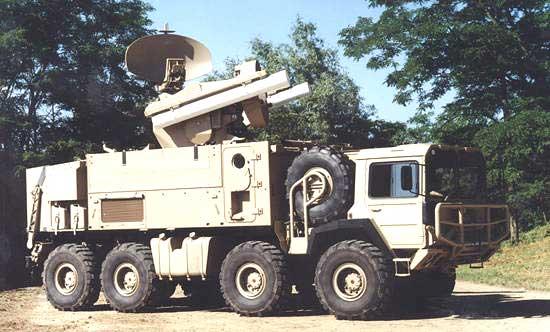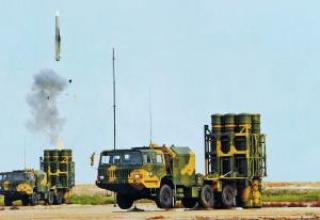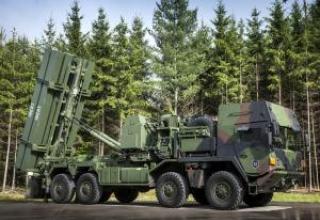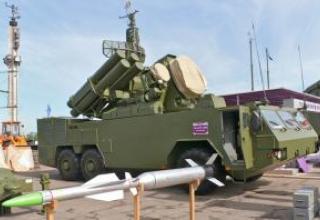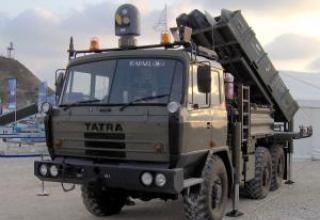All-weather self-propelled short-range air defense system "Roland-3" is designed and manufactured by EADS Euromissile and MBDA. Roland-3" SAM system is the result of consistent modernization of the family of anti-aircraft systems "Roland". It was adopted for service in 1988. The first serial models of the complex entered into service of the German Air Force air defense units and were used to cover German and American military airfields. 20 "Roland-3" complexes are in service with the German Airborne Division of the German Navy and are used for air defense of airfields, on which the Tornado fighter-bombers and Atlantic base patrol aircraft are based.
The complex is mounted on various landing gears. In the German Armed Forces it is mounted on the chassis of a 10-ton truck with cross-country ability MAN (8x8). The air transportable shelter variant, which received the designation "Roland Carol" (produced by SOFRAME) was adopted in 1995. In the French army "Roland Carol" SAM is placed on a semi-trailer towed by ACMAT (6x6), in the German Armed Forces it is installed on the MAN (6x6) chassis. Now the "Roland Carol" is in service with the French army (20 systems) and the German Air Force (11 systems). The "Roland Carol" can be carried by C-160 or C-130 aircraft. Loading takes less than 30 minutes and does not require special equipment.
In 1988 a joint program of the Ministries of Defense of Germany and France for further modernization of "Roland-3" SAM systems was adopted in order to extend their service life until 2010. In accordance with this program, "Roland-3" SAMs are equipped with modern sighting systems and new automatic control and guidance systems. The system is continuously upgraded through the development of new missiles, as well as through unification with existing systems (such as the Crotale-NG). The first samples of the complexes modernized for the French Armed Forces, which received the designation "Roland M3S", were tested in September 1999. German army "Roland" SAM system was equipped with a new digital control and guidance system, combined with the control, monitoring and warning system of the air defense of the German Army. The improved prototype under the designation of "Roland NDV" successfully passed military tests in 2003, data on serial production of the complex is not available.
Composition:
The Roland-3 complex includes a guidance system consisting of a three-axis X-band round-scan radar with a range and maximum altitude of target detection of 25 km and 9 km, respectively, identification device "your own", target tracking radars and missiles. There is an electron-optical visier equipped with an infrared direction finder. The range of detection with the help of electron-optical means of a complex of targets such as aircraft - up to 20 km, for the purposes of "helicopter" - 10 km. The tracking system includes radar and dual-band optical-electronic channels operating in parallel, with automatic selection of the optimal channel and the ability to switch between the channels at any time, including after starting the LSD. Range of radar and optical-electronic channels of tracking up to 20 km.
Ammunition complex - ten rockets "Roland": two - on the launching rails located on the sides of the rotating tower, eight - in two drum magazines inside the body of the car. Recharging is automatic. SAM reaction time (time between target detection and the beginning of automatic tracking) 6c - in radar mode and 3.5c in passive mode. The missile can be launched in 2 seconds after receiving the target for escort. The next missile can be launched on target in 2s after the previous target has been hit. Recharge time 6-10s. A new set of missiles can be charged within 2-5 minutes.
The Roland-3 is capable of using not only all Roland anti-aircraft missiles, but also a VT1 hypersonic missile (which is part of the Crotale-NG), as well as new promising Roland Mach 5 and HFK/KV missiles.
The upgraded Roland-3 missile, as compared to the Roland-2 missile, has an increased flight speed (570m/sec as compared to 500m/sec) and range (8km instead of 6.3km). It was adopted for service in 1989 and, while maintaining the same size, it has a 9.2 kg fragmentation warhead, which contains 5 kg of explosives and an increased number of fragments (84) compared to the prototype. The striking effect of the BC has been increased by the use of an upgraded fuse and an increase in the maximum fragment velocity to 5000 m/s. The maximum flight time is approximately 16 seconds. The time of operation of the new missile accelerator is determined by the minimum effective range (500m), but at the same time by 500 m increased to 6 km maximum altitude of targets. The target overload value (up to 9g) destroyed at the far border of the kill zone has also increased. The permitted missile overload is 17g.
Roland Mach 5 (RM5) missile has increased immunity to electromagnetic and infrared interference and is able to intercept armored helicopters, highly maneuverable support aircraft, and in some cases, the UAV, as well as cruise missiles. The RM5 missile is equipped with contact and non-contact fuses and has an 11kg shrapnel warhead with heavy shrapnel that has increased kinetic energy. The non-contact fuse is designed to fire at low altitudes and is effective against small targets. The kinetic energy of the missile in the event of a direct hit to a target is added to the striking effect of the BC. The RM5 has a powerful RTR with an optimal (progressive) thrust profile, which allows it to intercept air targets at long ranges and increases the probability of intercepting highly maneuverable targets at short ranges starting from 1.5 km. The maximum flight speed is 1600 m/s, at a range from 5 to 10 km - the average flight speed is 1000 m/s. The effective range of fire is 12km, the maximum range is 16km. The flight time of the missile is respectively: at a range of 8km - 7s, at a range of 10km - 10s, at a range of 12km - 13s. Maximum altitude reach is 8000m. The missile operates under conditions of very high overloads: at a range of 8km - 70g, at a range of 10km - 45g, at a range of 12km - 25g.
As an alternative to the VT-1 missile, the German company BGT is developing the HFK/KV hypersonic anti-aircraft guided missile. According to the calculations, the time to reach HFK/KV at a range of 12 km at a flight speed greater than M=5 will be 40% less than the VT-1 missile and more than half as long as the Roland-3 missile. The HFK/KV missile is designed to engage various air targets, including aircraft, helicopters, and tactical ballistic missiles. The concept of this missile provides that it will be equipped with an infrared sensor and an inertial unit. Initially, the missile did not provide for a combat unit - targets would be hit directly. However, the results of German simulations showed that direct hitting of an air target is not always possible, so the missile will use a small combat unit.
For the Roland M3S, Sagem and LFK have developed the GLAIVE optronic integrated rifle scope instead of the existing rifle scope as part of an intergovernmental agreement (France - Germany). The GLAIVE sight provides: automatic target tracking in infrared and optical range, calculation of target movement parameters in detection and tracking mode, as well as two-spectral missile tracking. The sight includes a thermal imager with a narrow and wide field of view, daytime TV camera, laser rangefinder, and infrared dual-band tracking system (1 and 10 µm).
The complex control system known as the BBKS (BBKS command and control function) was radically upgraded. The BBKS system includes:
- three multifunctional color displays providing air display for the complex commander and the operator.
- DHD (manufactured by LFK), providing control of the launcher and the rocket, as well as centralized testing and verification of the complex.
- A DEM (manufactured by MBDA), which provides information about the air situation and interaction with higher command posts and air defense control, monitoring and warning systems.
If it is necessary to cover air bases or other important objects, eight Roland-3 complexes can be combined into a single air defense system. Up to 6 "Roland-3" complexes can interact with each other, providing mutual cover. Air defense systems and portable air defense systems can receive information about all targets detected and accompanied by the Roland-3 complex.
In February 1988, the German Air Force received a unified command post FGR, developed by AEG. Totally 21 sets were supplied. Initially, as part of the control room FGR used a two-coordinate radar (see photo) with a linear frequency modulated signal can distinguish the aircraft from the helicopter, as well as detect anti-radar missiles and helicopters. The maximum angle of view of space is 60° from the smallest altitude to a height of 6 km. The range of target detection ranges with an effective reflective surface from 1m2 is 46 to 60 km. The antenna is mounted on a hydraulic mast with a height of 10m. The full antenna system is deployed and put on alert in 15 minutes. At present, a new three-axis G-band radar developed by EADS is used in the control room. For the new radar the range of target detection range with EPR 1m2 is from 1.5 to 100 km, with EPR 2m2 - up to 200km. The altitude range is from 300m to 10000m.
The Command Post (FGR) detects targets (this allows the Roland complex not to switch on its own overview radar, thus increasing its survivability), processes target information and displays it on the air situation indicator with indication of the threat type. The commander of the command post chooses one of his means of destruction. Up to 40 missile and anti-aircraft systems can close at the command post. The radio network and cable communication lines provide target designation to the selected weapon system for timely detection and capture of the target for escort. The data exchange cycle is two seconds. The calculation of the command post consists of four people. The equipment includes an indicator and electronic equipment of the radar, a requestor "insider", two operator's workplaces, a computer system for air situation analysis, a communication system, power supply, cooling systems and hydraulic equipment. There is its own navigation system for precise top linking. SEL SEM 80, SEM 90 or field phones are used to transmit voice information.
Characteristics:
| Rocket/parameter | Roland-3 | RM-5 | VT-1 |
| Defeat range, km> | 0.5-8 | 16 | 11 |
| Height of defeat, m. | 10-6000 | 8000 | 6000 |
| Starter weight, kg | 75 | - | 73 |
| Weight BC,kg | 9.2 | 11 | 13 |
| Length, mm | 2410 | 2550 | 2290 |
| Maximum housing diameter, mm | 160 | 170 | 165 |
| Swing of stabilizers, mm | 500 | 350 | 460 |
| Maximum flight speed, m/s | 570 | 1600 | 1250 |
| Target detection range with EPR=1m2, km | 16.5 |
| Escort range of the target, km: - radar channel (EPR=1m2) - optical channel |
15 15 |
| The reaction time, s | 4-10 |
| Ammunition | 10 (4 on PU) |
| Number of simultaneously fired targets | 1 |
| Productivity, sharp targets/min. | 3-4 |
| Weight of combat vehicle, kg | 27500 |
| Length, m | 9.8 |
| Width, m | 2.9 |
| Crew, man. | 3 |
| Maximum speed on the highway, km/h. | 90 |
| Traffic reserve on the highway, km | 800 |
Testing:
In November 1986, the Qatari army placed an order for the production of three batteries in three complexes each. One battery used AMX-30 type chassis, and the other two used stationary type chassis. Delivery and training of combat calculations was completed in 1989.
Brazil received four Roland-2 complexes on Marder chassis with 50 missiles.
In 1984, the Spanish Ministry of Defense chose the "Roland-2" complex to equip its mobile low-altitude air defense batteries, there was signed a contract for the integration and joint production of this weapons system (9 "Roland-1" and 9 "Roland-2" complexes on AMH-30 MW chassis with 414 missiles).
In 1991 "Roland-2" complex was used by Iraq against coalition forces during the operation "Desert Storm". By the beginning of 1991 the armed forces of Iraq had from 40 to 100 "Roland-2" complexes according to different data. Presumably, these complexes shot down two Tornado aircraft.
Sources:
- Army Technology - Roland - Short Range Air Defence Missile System
- Василин Н.Я., Гуринович А.Л. "Зенитные ракетные комплексы" .-Мн.: ООО "Попурри", 2002- 464с.
- Толин А. "Артиллерийские зенитные установки". Зарубежное военное обозрение №1, 1985
- В.Коровин "К цели - на гиперзвуке"
- "ROLAND - FGR (BW)"
- "TRML-2D"
